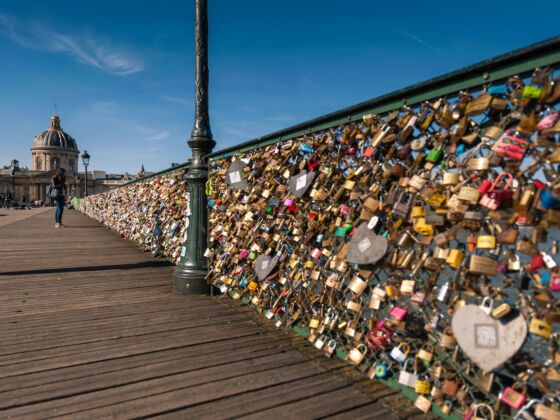THE PARIS “LOVE BRIDGE” has partially collapsed, proving that structural integrity is just as important as eternal devotion. The bridge, which is actually called the Pont des Arts, has become famous in the last several years for its padlocks, which are placed on the chainlink guardrails by lovers, who then lock them and toss the keys into the Seine as a romantic gesture.

The Paris "Love Bridge" Is Collapsing Under the Weight of Your Love
Yesterday, 2.4 meters of the guardrail at the Pont des Arts collapsed under the weight, and local authorities quickly evacuated the bridge and shut it down. The Parisian government (and Parisians themselves) have been asking tourists not to put locks on the bridge for years now, citing exactly what happened on Sunday.
The “love locks” tradition isn’t remotely new, and it didn’t originate in Paris. It’s believed to have begun at Most Ljubavi, a bridge in the Serbian town of Vrnjačka Banja, around the time of World War I. A local schoolteacher fell in love with a soldier and got engaged. The two would meet at Most Ljubavi every night, until he went off to war, where he fell in love with a Greek woman and called off the engagement. The schoolteacher died of heartbreak, and the local girls began writing the names of themselves and their lovers onto locks, and then placing those locks onto the bridge to keep the same thing from happening to them.
The tradition has taken off in the last 15 years especially, after being featured in a number of books and movies. An Italian romance novel called I Want You and the subsequent film adaptation kicked off a love-lock explosion on Ponte Milvio in Rome, and a recent episode of “Parks and Recreation” featured two of the main characters putting locks on Pont des Arts, which couldn’t have helped their lock problem.
And it’s not limited to these cities: The Hohenzollern Bridge in Cologne, Germany is a love lock bridge, as are the chainlinks on Mount Huang in China. There are love locks in Tel Aviv, London, Tokyo, Antwerp, Buenos Aires, Moscow, Sevilla, Ottawa, and Montevideo. The New York City Department of Transportation recently asked people to stop placing them on the Brooklyn Bridge.
Even in Paris, the tradition is hardly limited to the Pont des Arts. If you walk along the Seine, you’ll find pretty much any bridge that has a chainlink you can snap a padlock onto has several, presumably put their by tourists who weren’t sure which bridge they were supposed to go to, or who just wanted to be renegades. When I was in Paris this spring, there were vendors standing on the bridge and selling locks, as well as markers so you could write your names on them. Some of the locks had names professionally engraved. My fiancee and I may or may not have taken part in the tradition ourselves. (Seriously Paris, we’re sorry about that. Or, you know, if I was confirming that we had done it, I’d be sorry.) Recently, padlocks were even removed from the Eiffel Tower.
If you’re not the type of person who has any architectural knowledge, love locks are a pretty cute tradition. It’s hard to go to the Pont des Arts and not feel slightly heartwarmed that so many couples in love have made their way across the bridge in the mere handful of years of the tradition there.
But it may be time for this tradition to come to a hasty end. It’s just not something that suits itself for a world with 7 billion people and god knows how many romantic relationships. And while I personally love the idea of eternally commemorating my love somehow, I don’t want to commemorate it with the headline “17 DIE IN BRIDGE COLLAPSE.”
Here are a few other ideas for how you can best commemorate your love:
- Plant a tree.
- Take a kissing selfie so all of your Facebook friends will hate you.
- Just write your name over the top of someone else’s lock.
- Buy a star.
- Fuck like rabbits. Nothing says “we’re doing this forever” like a baby.
Another possibility is to only put up locks for actual long-term relationships. No flings allowed. I was in Dublin a few years ago, where the Ha’penny Bridge had become a love-lock bridge (though all the locks have since been removed by the city).
A Dubliner, suggesting a possible solution for those who are slightly less committed, said, “In Paris, when two lovers fall in love, they put a padlock on the bridge and throw the key into the Seine, as a grand symbolic gesture. Here in Ireland, we know better. We put on a combination lock and come back later to take it off.”